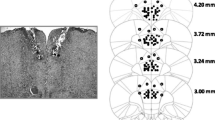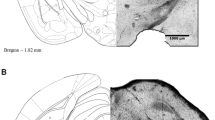Abstract
In order to localise the often reported anxiolytic action of N-methyl-D-aspartate (NMDA) receptor antagonists, 2-amino-7-phosphonoheptanoic acid (AP7) was injected into the dorsal periaqueductal grey (DPAG) of rats exposed to the elevated plus-maze model of anxiety. Doses of 0.2, 2 and 20 nmol AP7 caused a dose-dependent increase in the percentage of open arm entries, the effect of the last two doses being significantly different from control. A non-significant tendency to increase the percentage of time spent on the open arms of the maze was also noticed. In contrast, the total number of entries into either the open or enclosed arms was not affected. Injections of AP7 localized outside the DPAG were ineffective. Therefore, microinjection of AP7 into the DPAG caused a selective anxiolytic effect in the elevated plusmaze. It may be suggested that the DPAG is a site of the anxiolytic action of NMDA antagonists reported following systemic administration.
Similar content being viewed by others
References
Audi EA, de Oliveira CE, Graeff FG (1989) Serotonergic mediation of the anxiolytic effect of intracerebrally injected propranolol measured in the elevated plus-maze. Braz J Med Biol Res 22:699–701
Bandler R (1984) Identification of hypothalamic and midbrain periaqueductal grey neurones mediating aggressive and defensive behaviour by microinjections of excitatory aminoacids. In: Bandler R (ed) Modulation of sensorimotor activity during alterations in behavioral states. Liss, New York, pp 369–391
Beart PM, Nicolopoulos LS, West DC, Headley PM (1988) An excitatory amino acid projection from ventromedial hypothalamus to periaqueductal gray in the rat: autoradiographic and electrophysiological evidence. Neurosci Lett 85:205–211
Beitz AJ (1989) Possible origin of glutamatergic projections to the midbrain periaqueductal gray and deep layer of the superior colliculus of the rat. Brain Res Bull 23:25–35
Bennett DA, Amrick CL (1986) 2-amino-7-phosphonoheptanoic acid (AP7) produces discriminative stimuli and anticonflict effects similar to diazepam. Life Sci 39:2455–2461
Brandão ML, Fontes JCS, Graeff FG (1980) Facilitatory effect of ketamine on punished behavior. Pharmacol Biochem Behav 13:1–4
Carobrez AP (1987) Excitatory amino acid mediation of the defence reaction. In: Brandão ML (ed) Neurosciences and behavior. UFES-Grafica, Vitória, Brazil, pp 21–29
Cavalheiro EA, Lehman J, Turski L (1988) Frontiers in excitatory amino acid research. Liss, New York
Clineschmidt B, Williams M, Witoslawski J, Bunting P, Risley A, Totaro J (1982) Restoration of shock-suppressed behavior by treatment with (+)-5-methyl-10,11-dihydro-5H-dibenzo[a,d]-cyclohepten-5,10-imine (MK-801), a substance with potent anticonvulsant, central sympathomimetic, and apparent anxiolytic properties. Drug Dev Res 2:147–163
Graeff FG (1984) The anti-aversive action of minor tranquillizers. TIPS 5:230–233
Graeff FG (1987) The antiaversive action of drugs. In: Thompson T, Dews PB, Barrett JE (eds) Neurobehavioral pharmacology. Lawrence Erlbaum, Hillsdale, New Jersey, pp 129–156
Graeff FG (1988) Animal models of aversion. In: Simon P, Soubrié, Wiedlocher D (eds) Selected models of anxiety, depression and psychosis. Karger, Basel, pp 115–141
Graeff FG (1990) Brain defence system and anxiety. In: Roth M, Burrows GD, Noyes R (eds) Handbook of anxiety, Vol 3. Elsevier, Amsterdam, pp 307–354
Graeff FG, Brandão ML, Audi EA, Schütz MTB (1986) Modulation of the brain aversive system by GABAergic and serotonergic mechanisms. Behav Brain Res 21:65–72
Graeff FG, Carobrez AP, Silveira MCL (1988) Excitatory amino acids and the brain aversive system. In: Cavalheiro EA, Lehman J, Turski L (eds) Frontiers in excitatory amino acid research. Liss, New York, pp 325–332
König JFR, Klippel RA (1963) The rat brain in stereotaxic coordinates. Williams and Wilkins, Baltimore.
Kostowski W, Plaznik A, Stefanski R (1989) Intra-hippocampal buspirone in animal models of anxiety. Eur J Pharmacol 168:393–396
Krieger JE, Graeff FG (1985) Defensive behavior and hypertension induced by glutamate in the midbrain central gray of the rat. Braz J Med Biol Res 18:61–67
Pellow S, Chopin P, File SE, Briley M (1985) Validation of open: closed arm entries in an elevated plus-maze as a measure of anxiety in the rat. J Neurosci Methods 14:149–167
Porter JH, Wiley JL, Balster RL (1989) Effects of phencyclidine-like drugs on punished behavior in rats J Pharmacol Exp Ther 248:997–1002
Stephens DN, Meldrum BS, Weidmann R, Schneider C, Grutzner M (1986) Does the excitatory amino-acid receptor antagonist 2-APH exhibit anxiolytic activity? Psychopharmacology 90:166–169
Wenger GR (1980) Effects of phencyclidine and ketamine in pigeons on behavior suppressed by brief electrical shocks. Pharmacol Biochem Behav 12:865–870
Author information
Authors and Affiliations
Rights and permissions
About this article
Cite this article
Guimarães, F.S., Carobrez, A.P., De Aguiar, J.C. et al. Anxiolytic effect in the elevated plus-maze of the NMDA receptor antagonist AP7 microinjected into the dorsal periaqueductal grey. Psychopharmacology 103, 91–94 (1991). https://doi.org/10.1007/BF02244080
Received:
Issue Date:
DOI: https://doi.org/10.1007/BF02244080




